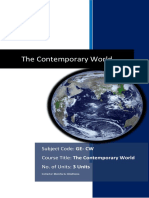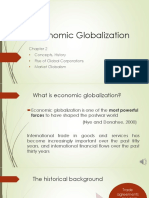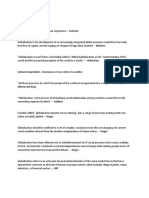0 ratings0% found this document useful (0 votes)
2 viewsMidterm Pointer
Globalization is a complex process characterized by the increasing interconnectedness of economies, cultures, and societies across the globe. It encompasses various dimensions such as economic integration, cultural exchange, and the movement of people and information, often leading to both homogeneity and heterogeneity in global practices. The phenomenon has evolved through distinct phases, including the Agricultural Revolution, Industrial Revolution, and Information Revolution, significantly impacting global trade and the roles of transnational corporations.
Uploaded by
Rizza Dela RosaCopyright
© © All Rights Reserved
Available Formats
Download as DOCX, PDF, TXT or read online on Scribd
0 ratings0% found this document useful (0 votes)
2 viewsMidterm Pointer
Globalization is a complex process characterized by the increasing interconnectedness of economies, cultures, and societies across the globe. It encompasses various dimensions such as economic integration, cultural exchange, and the movement of people and information, often leading to both homogeneity and heterogeneity in global practices. The phenomenon has evolved through distinct phases, including the Agricultural Revolution, Industrial Revolution, and Information Revolution, significantly impacting global trade and the roles of transnational corporations.
Uploaded by
Rizza Dela RosaCopyright
© © All Rights Reserved
Available Formats
Download as DOCX, PDF, TXT or read online on Scribd
You are on page 1/ 4
What is Globalization?
growth of “supraterritorial” relations
Perhaps you heard the phrase “The world is between people. – Scholte, 2000
getting smaller.” This is primarily because of 9. Globalization is a process of cross-cultural
the primary driving force of the interaction, exchange, and transformation. –
contemporary world which is globalization. Cooppan, 2001
The concept of globalization is complex and
multifaceted. It is a phenomenon that most of the definitions regarding
occurs at multiple levels and a process that globalization pertain to it as an economic
affects people differently (Abinales & process. Globalization is usually used to
Claudio, 2018). refer to the integration of national markets
Some of these definitions are as follows: to a wider global market signified by the
1. Globalization means the onset of the increased free trade.
borderless world. – Ohmae, 1992
2. Globalization is a trans planetary process The best scholarly description of
or set of processes involving increasing globalization is given by globalization expert
liquidity and the growing multidirectional Manfred Steger (Abinales & Claudio, 2018).
flows of people, objects, places, and Steger described globalization as the
information as well as the structures they “expansion and intensification of social
encounter and create that are barriers to, or relations and consciousness across world-
expedite, those flows. – Ritzer, 2015 time and across world- space.”
3. Globalization is the intensification of For anthropologist Arjun Appadurai,
worldwide social relations which link distant different kinds of globalization occur on the
localities in such a way that local multiple and intersecting dimensions of
happenings are shaped by events occurring integration that he calls “scapes” pertaining
many miles away and vice versa. – Giddens, to the following:
1990 1. Ethnoscape. This refers to the global
4. Globalization refers to the compression of movement of people.
the world and the intensification of 2. Mediascape. This refers to the flow of
consciousness of the world as a whole. – culture.
Robertson, 1992 3. Technoscape. This refers to the circulation
5. Globalization is the phenomenon by of mechanical goods and software.
which markets and production in different 4. Financescape. This denotes the global
countries are becoming increasingly circulation of money.
interdependent due to the dynamics of 5. Ideoscape. This is the realm where
trade in goods and services and the flows of political ideas move around.
capital technology. – OECD, 2002
6. Globalization implies the weakening of Theories on Globalization: How does
state sovereignty and state structures. – globalization take place?
Beck, 2000 globalization see globalization as a process
7. Globalization is the establishment of a that increases homogeneity or
global market free from socio-political heterogeneity. Homogeneity refers to the
control. – Nikitin and Elliott, 2003 8. increasing sameness in the world as cultural
Globalization is “de-territorialization” or the inputs, economic factors, and political
orientations of societies expand to create
common practices, same economies, and There are two types of economies
similar forms of government. Homogeneity associated with economic globalization:
in globalization is associated with the 1. Protectionism. This is a policy of
following concepts: systematic government intervention in
Cultural imperialism is a concept that means foreign trade with the objective of
that a given culture influences other encouraging domestic production. This
cultures. This pertains to the imposition by usually comes in the form of quotas and
one usually politically or economically tariffs.
dominant community of various aspects of 2. Trade Liberalization or Free Trade. This is
its own culture onto another nondominant a policy wherein trade practices that
community. Media Imperialism refers to the impede free flow of goods and services
global flow of media imposed to developing from one country to another are removed
countries by the West. Neoliberalism sees or reduced. This includes dismantling of
competition as the defining characteristic of tariff and non-tariff barriers
human relations. It redefines citizens as
consumers, whose democratic choices are Free Trade Agreement A free trade
best exercised by buying and selling, a agreement is a pact between two or more
process that rewards merit and punishes nations to reduce barriers to imports and
inefficiency. McDonaldization is the process exports among them.
by which Western societies are dominated A government doesn't need to take specific
by the principles of fast-food restaurants. action to promote free trade. This hands-
This concept was developed by American off stance is referred to as “laissez-faire
sociologist George Ritzer which refers to the trade
particular kind of rationalization of
production, work, and consumption that The European Union is a notable example
rose to prominence in the late twentieth of free trade today. The member nations
century. form an essentially borderless single entity
for the purposes of trade, and the adoption
Global Economy and Market Integration of the euro by most of those nations
smooths the way further.
Global economy is also referred to as world
economy. This term refers to the The development of global market
international exchange of goods and integration happened in the following
services that is expressed in monetary units phases:
of money. It may also mean as the free First Phase: The Agricultural Revolution.
movement of goods, capital, services, People learned how to domesticate animals
technology, and information. economic and plants.
globalization which is concerned on the Second Phase: Industrial Revolution (17th
globalization of production, finance, Century). The rise of industry led to the
markets, technology, organizational emergence of new economic tools. People
regimes, institutions, corporations, and started working in factories as wage
labor. laborers and became more specialized in
their skills. Two economic models emerged
during the time of the Industrial Revolution
– capitalism and socialism. Capitalism is a efficient trade. The countries established a
system in which all-natural resources and common basis for currency prices and a
means of production are privately owned. It fixed exchange rate system – all based on
emphasizes profit maximization and the value of gold.
competition as the main drivers of
efficiency. This is referred to by the The Bretton Woods System has the
economist Adam Smith as the “invisible following key elements: (Almeda, 2018)
hand” of the market. 1. The expression of currency in terms of
gold or gold value to establish a par value
Socialism, on the other hand, is a system 2. The official monetary authority in each
wherein the means of production are under country would agree to exchange its own
collective ownership. It rejects the private currency for those of other countries at the
property and hands-off approach. established exchange rates, plus or minus a
one-percent margin
3. Eliminating restrictions on the currencies
Third Phase: The Information Revolution. of member states in international trade
Currently, this is a period wherein 4. US dollar as the global currency.
technology has reduced the role of human
labor and shifted it from a manufacturing- Delegates at Bretton Woods agreed to
based economy to one that is based on create the following *international financial
service work and the production of ideas institutions:
rather than goods. primary labor market 1. WB (World Bank). Also known as the
(white collar professions) and secondary International Bank for Reconstruction and
labor market (blue collar professions). Development (IBRD), its main goal is to fund
Primary labor market includes jobs postwar reconstruction projects gearing
characterized by higher incomes and job towards the eradication of poverty in
security while secondary labor markets countries devastated by war.
include lower-level service sectors that have 2. IMF (International Monetary Fund). This
lesser pay and lesser job security. served as a lender or a last resort for
countries which needed financial assistance.
International Trading Systems
Neoliberalism, ideology and policy model
International trade happened way back in that emphasizes the value of free
the old world. This is the oldest known market competition. Although there is
international trade was the Silk Road. It is a considerable debate as to the defining
network of pathways in the ancient world features of neoliberal thought and practice,
that spanned from China to what is now the it is most commonly associated with laissez-
Middle East and to Europe. faire economics. In particular, neoliberalism
is often characterized in terms of its belief in
United Kingdom, the United States and sustained economic growth as the means to
other European Nations adopted the gold achieve human progress, its confidence in
standard at an international monetary free markets as the most-efficient allocation
conference in Paris. Its goal was to create a of resources, its emphasis on minimal state
common system that would allow for more intervention in economic and social affairs,
and its commitment to the freedom
of trade and capital.
The beneficiaries of global commerce have
been mainly transnational corporations
(TNCs) and not governments (Abinales &
Claudio, 2018) Transnational Corporations
are companies that extend beyond the
borders of one country. These are also
referred to as multinational corporations or
global corporations. They intentionally
surpass national borders and take
advantage of opportunities in different
countries to manufacture, distribute,
market, and sell their products.
Economic Globalization
In the recent decades, partly as a result of
the increased exports, economic
globalization has ushered in an
unprecedented spike in global growth rates.
According to the IMF, the global per capita
rose over five-fold in the second half of the
20th century. It was growth that created the
large Asian economies like Japan, China,
Korea, Hong Kong, and Singapore.
You might also like
- PLT College, Inc.: College of Arts and Sciences and EducationNo ratings yetPLT College, Inc.: College of Arts and Sciences and Education3 pages
- Lesson 1 - Contemporary World: Why Do You Need To Study The World?No ratings yetLesson 1 - Contemporary World: Why Do You Need To Study The World?23 pages
- Chapter 7 - Globalization and the MillennialsNo ratings yetChapter 7 - Globalization and the Millennials15 pages
- 6 SocSc 03 Chapter 2 Economic GlobalizationNo ratings yet6 SocSc 03 Chapter 2 Economic Globalization28 pages
- Two Different Types of Economic GlobalizationNo ratings yetTwo Different Types of Economic Globalization2 pages
- REVIEWER in The Contemporary World_MidtermNo ratings yetREVIEWER in The Contemporary World_Midterm10 pages
- Structures of Globalization: Economic Globalization Political Globalization Cultural GlobalizationNo ratings yetStructures of Globalization: Economic Globalization Political Globalization Cultural Globalization16 pages
- The Contemporary World Module - Lesson 2No ratings yetThe Contemporary World Module - Lesson 211 pages
- TCW Economic Globalization (4 Files Merged)No ratings yetTCW Economic Globalization (4 Files Merged)77 pages
- VND Openxmlformats-Officedocument Wordprocessingml Documentrendition1No ratings yetVND Openxmlformats-Officedocument Wordprocessingml Documentrendition118 pages
- The Globalization of World Economics FCNo ratings yetThe Globalization of World Economics FC26 pages
- Contemporary World Lessons-Study-Guide-2No ratings yetContemporary World Lessons-Study-Guide-226 pages
- Apostol Portfolio in Contemporary - 20231202 - 202512 - 0000No ratings yetApostol Portfolio in Contemporary - 20231202 - 202512 - 000016 pages
- The Keynesian Revolution and Its CriticsNo ratings yetThe Keynesian Revolution and Its Critics21 pages
- Strategic Space Planning Simplified: Novel Tips & Techniques For Today's Space PlannersNo ratings yetStrategic Space Planning Simplified: Novel Tips & Techniques For Today's Space Planners14 pages
- Complete Download (eBook PDF) Lipsey and Christo Economics 14th Edition PDF All Chapters100% (5)Complete Download (eBook PDF) Lipsey and Christo Economics 14th Edition PDF All Chapters35 pages
- ICO Olympiad Sample Paper 2 For Class 12 With Solutions100% (1)ICO Olympiad Sample Paper 2 For Class 12 With Solutions29 pages
- Socio-Economic Factors Affecting Business and Industry G-3No ratings yetSocio-Economic Factors Affecting Business and Industry G-311 pages
- June 2019 MS - Paper 2 Edexcel (A) Economics As-LevelNo ratings yetJune 2019 MS - Paper 2 Edexcel (A) Economics As-Level19 pages
- Macroeconomic Theory ECO208 - Chapter 1: Murat Alp CelikNo ratings yetMacroeconomic Theory ECO208 - Chapter 1: Murat Alp Celik12 pages
- Macroeconomics Canadian 7th Edition Abel Test Bank - All Chapters Are Available In PDF Format For Download100% (2)Macroeconomics Canadian 7th Edition Abel Test Bank - All Chapters Are Available In PDF Format For Download50 pages
- Measuring The Cost of Living: Principles: Chapter 21No ratings yetMeasuring The Cost of Living: Principles: Chapter 2116 pages
- Table 141: India'S Overall Balance of Payments - RupeesNo ratings yetTable 141: India'S Overall Balance of Payments - Rupees2 pages
- Langdana, F. Macroeconomic Policy Demystifying Monetary and Fiscal Policy. Cap. 4No ratings yetLangdana, F. Macroeconomic Policy Demystifying Monetary and Fiscal Policy. Cap. 426 pages
- 11 Reasons Why The Federal Reserve Is BadNo ratings yet11 Reasons Why The Federal Reserve Is Bad4 pages
- PLT College, Inc.: College of Arts and Sciences and EducationPLT College, Inc.: College of Arts and Sciences and Education
- Lesson 1 - Contemporary World: Why Do You Need To Study The World?Lesson 1 - Contemporary World: Why Do You Need To Study The World?
- Structures of Globalization: Economic Globalization Political Globalization Cultural GlobalizationStructures of Globalization: Economic Globalization Political Globalization Cultural Globalization
- VND Openxmlformats-Officedocument Wordprocessingml Documentrendition1VND Openxmlformats-Officedocument Wordprocessingml Documentrendition1
- Apostol Portfolio in Contemporary - 20231202 - 202512 - 0000Apostol Portfolio in Contemporary - 20231202 - 202512 - 0000
- Strategic Space Planning Simplified: Novel Tips & Techniques For Today's Space PlannersStrategic Space Planning Simplified: Novel Tips & Techniques For Today's Space Planners
- Complete Download (eBook PDF) Lipsey and Christo Economics 14th Edition PDF All ChaptersComplete Download (eBook PDF) Lipsey and Christo Economics 14th Edition PDF All Chapters
- ICO Olympiad Sample Paper 2 For Class 12 With SolutionsICO Olympiad Sample Paper 2 For Class 12 With Solutions
- Socio-Economic Factors Affecting Business and Industry G-3Socio-Economic Factors Affecting Business and Industry G-3
- June 2019 MS - Paper 2 Edexcel (A) Economics As-LevelJune 2019 MS - Paper 2 Edexcel (A) Economics As-Level
- Macroeconomic Theory ECO208 - Chapter 1: Murat Alp CelikMacroeconomic Theory ECO208 - Chapter 1: Murat Alp Celik
- Macroeconomics Canadian 7th Edition Abel Test Bank - All Chapters Are Available In PDF Format For DownloadMacroeconomics Canadian 7th Edition Abel Test Bank - All Chapters Are Available In PDF Format For Download
- Measuring The Cost of Living: Principles: Chapter 21Measuring The Cost of Living: Principles: Chapter 21
- Table 141: India'S Overall Balance of Payments - RupeesTable 141: India'S Overall Balance of Payments - Rupees
- Langdana, F. Macroeconomic Policy Demystifying Monetary and Fiscal Policy. Cap. 4Langdana, F. Macroeconomic Policy Demystifying Monetary and Fiscal Policy. Cap. 4

























































































